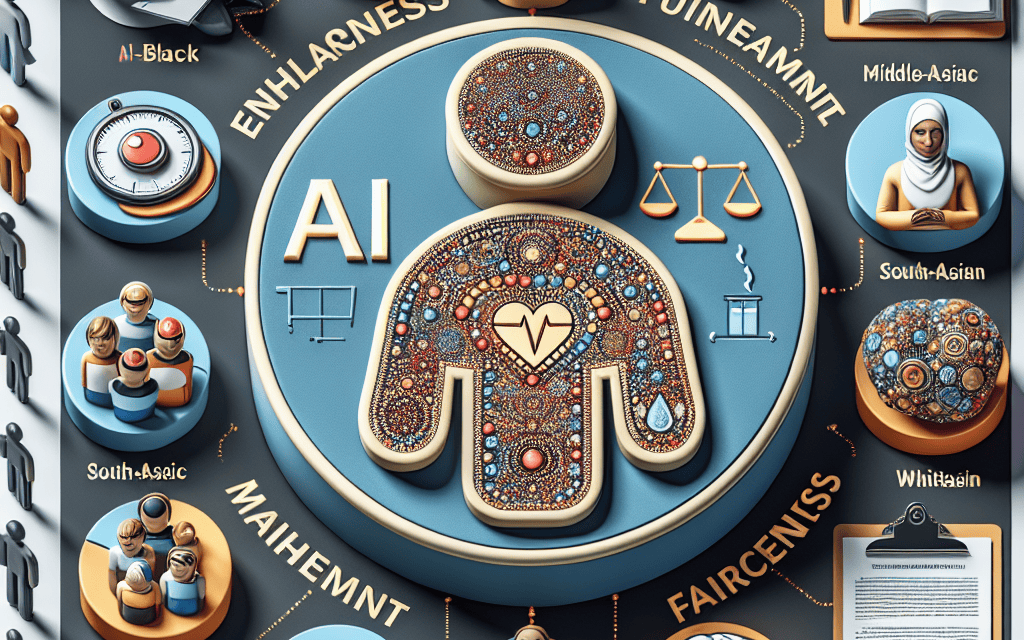Study Reveals AI’s Potential to Enhance Fairness in Pain Management

In recent years, artificial intelligence (AI) has emerged as a transformative force across various sectors, including healthcare. One of the most promising applications of AI in healthcare is its potential to enhance fairness in pain management. Pain management has long been fraught with challenges, including biases in treatment and disparities in access to care. This article delves into the potential of AI to address these issues, exploring how it can improve diagnosis, personalize treatment, reduce biases, and ultimately lead to more equitable healthcare outcomes.
Understanding the Current Challenges in Pain Management
Pain management is a critical component of healthcare, yet it remains one of the most complex and subjective areas of medical practice. Patients often report varying levels of pain, and healthcare providers must rely on subjective assessments to determine the appropriate course of treatment. This section explores the current challenges in pain management, including the limitations of traditional methods and the impact of biases on patient care.
The Subjectivity of Pain Assessment
Pain is inherently subjective, making it difficult to measure and treat effectively. Traditional pain assessment methods, such as the Visual Analog Scale (VAS) and the Numeric Rating Scale (NRS), rely on patients’ self-reported pain levels. These methods are limited by their reliance on subjective input, which can vary significantly between individuals. Factors such as cultural background, language barriers, and personal pain tolerance can all influence how patients report their pain.
Moreover, healthcare providers’ interpretations of these assessments can be influenced by their own biases and experiences. This subjectivity can lead to inconsistencies in pain management, with some patients receiving inadequate treatment while others may be overtreated. The need for more objective and standardized methods of pain assessment is evident, and AI offers a promising solution.
Disparities in Pain Management
Disparities in pain management are well-documented, with certain populations experiencing unequal access to pain relief. Studies have shown that racial and ethnic minorities, women, and low-income individuals are less likely to receive adequate pain management compared to their counterparts. These disparities can be attributed to a variety of factors, including implicit biases among healthcare providers, differences in healthcare access, and socioeconomic barriers.
For example, research has found that Black patients are less likely to receive opioid prescriptions for pain management compared to White patients, even when presenting with similar symptoms. This disparity is partly due to implicit biases that lead healthcare providers to underestimate the pain levels of minority patients. Addressing these disparities is crucial for ensuring equitable healthcare outcomes, and AI has the potential to play a significant role in this effort.
The Opioid Crisis and Its Impact on Pain Management
The opioid crisis has further complicated the landscape of pain management. The overprescription of opioids has led to widespread addiction and overdose deaths, prompting healthcare providers to adopt more conservative approaches to pain management. While this shift is necessary to address the opioid epidemic, it has also resulted in some patients being undertreated for their pain.
AI can help balance the need for effective pain management with the risks associated with opioid use. By analyzing large datasets and identifying patterns, AI can assist healthcare providers in making more informed decisions about when and how to prescribe opioids, potentially reducing the risk of addiction while ensuring that patients receive adequate pain relief.
The Role of AI in Addressing Biases
Biases in pain management can have significant consequences for patient care. Implicit biases, which are unconscious attitudes or stereotypes that affect decision-making, can lead to disparities in treatment. AI has the potential to mitigate these biases by providing more objective and data-driven insights into pain management.
For instance, AI algorithms can analyze patient data to identify patterns and trends that may not be immediately apparent to human providers. By highlighting these patterns, AI can help healthcare providers recognize and address their own biases, leading to more equitable treatment decisions. Additionally, AI can be used to develop standardized pain assessment tools that reduce the influence of subjective biases on treatment decisions.
The Need for Personalized Pain Management
Every patient’s experience of pain is unique, influenced by a variety of factors including genetics, medical history, and psychological state. Personalized pain management, which tailors treatment to the individual needs of each patient, is essential for effective care. However, achieving this level of personalization can be challenging with traditional methods.
AI offers a solution by enabling more precise and personalized pain management strategies. By analyzing large datasets, AI can identify patterns and correlations that inform personalized treatment plans. For example, AI can help determine which patients are most likely to benefit from specific pain management interventions, such as physical therapy, medication, or alternative therapies. This personalized approach can lead to more effective pain relief and improved patient outcomes.
AI’s Role in Enhancing Pain Diagnosis
Accurate diagnosis is the cornerstone of effective pain management. However, diagnosing pain can be challenging due to its subjective nature and the wide range of potential underlying causes. AI has the potential to revolutionize pain diagnosis by providing more accurate and objective assessments. This section explores how AI can enhance pain diagnosis through advanced imaging techniques, predictive analytics, and machine learning algorithms.
Advanced Imaging Techniques
Imaging techniques such as MRI and CT scans are commonly used in pain diagnosis to identify structural abnormalities that may be causing pain. However, interpreting these images can be complex and time-consuming, requiring specialized expertise. AI can enhance the accuracy and efficiency of image interpretation by automating the analysis process.
For example, AI algorithms can be trained to recognize patterns in imaging data that are indicative of specific pain conditions, such as herniated discs or joint degeneration. By automating the analysis process, AI can reduce the risk of human error and provide more consistent and accurate diagnoses. Additionally, AI can assist in identifying subtle changes in imaging data that may be overlooked by human observers, leading to earlier detection and intervention.
Predictive Analytics for Pain Diagnosis
Predictive analytics involves using data analysis techniques to identify patterns and make predictions about future outcomes. In the context of pain diagnosis, predictive analytics can be used to identify patients who are at risk of developing chronic pain conditions or experiencing pain flare-ups.
AI can analyze large datasets, including electronic health records and patient-reported outcomes, to identify risk factors and patterns associated with pain conditions. By identifying these patterns, AI can help healthcare providers make more informed decisions about pain management strategies, potentially preventing the progression of acute pain to chronic pain. This proactive approach can lead to better patient outcomes and reduce the burden of chronic pain on healthcare systems.
Machine Learning Algorithms for Pain Assessment
Machine learning is a subset of AI that involves training algorithms to learn from data and make predictions or decisions. In the context of pain assessment, machine learning algorithms can be used to develop more objective and accurate tools for measuring pain levels.
For example, machine learning algorithms can analyze data from wearable devices, such as heart rate monitors and activity trackers, to assess pain levels based on physiological indicators. By combining this data with patient-reported outcomes, AI can provide a more comprehensive and objective assessment of pain levels. This approach can reduce the reliance on subjective self-reports and provide healthcare providers with more accurate information for making treatment decisions.
Case Studies: AI in Pain Diagnosis
Several case studies have demonstrated the potential of AI to enhance pain diagnosis. For example, a study conducted at Stanford University used machine learning algorithms to analyze MRI data and accurately diagnose lower back pain conditions. The AI model was able to identify specific pain conditions with a high degree of accuracy, outperforming human radiologists in some cases.
Another study conducted at the University of California, San Francisco, used AI to analyze electronic health records and identify patients at risk of developing chronic pain after surgery. The AI model was able to predict chronic pain outcomes with a high degree of accuracy, allowing healthcare providers to implement targeted interventions to prevent the progression of pain.
The Future of AI in Pain Diagnosis
The potential of AI to enhance pain diagnosis is vast, and ongoing research is exploring new applications and techniques. As AI technology continues to advance, it is likely that we will see even more sophisticated and accurate tools for pain diagnosis. These advancements have the potential to revolutionize pain management, leading to more accurate diagnoses, personalized treatment plans, and improved patient outcomes.
However, the integration of AI into pain diagnosis also presents challenges, including the need for robust data privacy and security measures, as well as the need for ongoing training and education for healthcare providers. Addressing these challenges will be essential for realizing the full potential of AI in pain diagnosis and ensuring that it is used ethically and effectively.
Personalizing Pain Management with AI
Personalized medicine is an emerging approach that tailors medical treatment to the individual characteristics of each patient. In the context of pain management, personalization involves developing treatment plans that are specifically designed to meet the unique needs of each patient. AI has the potential to enhance personalized pain management by providing more precise and data-driven insights into treatment options. This section explores how AI can be used to personalize pain management, including the development of personalized treatment plans, the use of predictive analytics, and the integration of patient-reported outcomes.
Developing Personalized Treatment Plans
AI can be used to develop personalized treatment plans by analyzing large datasets to identify patterns and correlations that inform treatment decisions. For example, AI can analyze data from electronic health records, genetic information, and patient-reported outcomes to identify which patients are most likely to benefit from specific pain management interventions.
By identifying these patterns, AI can help healthcare providers develop treatment plans that are tailored to the individual needs of each patient. This personalized approach can lead to more effective pain relief and improved patient outcomes. Additionally, AI can assist in monitoring patient progress and adjusting treatment plans as needed, ensuring that patients receive the most appropriate care at each stage of their treatment journey.
Predictive Analytics for Personalized Pain Management
Predictive analytics can be used to identify patients who are at risk of developing chronic pain conditions or experiencing pain flare-ups. By analyzing large datasets, AI can identify risk factors and patterns associated with pain conditions, allowing healthcare providers to implement targeted interventions to prevent the progression of pain.
For example, AI can analyze data from wearable devices, such as heart rate monitors and activity trackers, to assess pain levels based on physiological indicators. By combining this data with patient-reported outcomes, AI can provide a more comprehensive and objective assessment of pain levels. This approach can reduce the reliance on subjective self-reports and provide healthcare providers with more accurate information for making treatment decisions.
Integrating Patient-Reported Outcomes
Patient-reported outcomes (PROs) are an important component of personalized pain management, as they provide valuable insights into patients’ experiences and perceptions of their pain. AI can be used to analyze PROs and identify patterns and trends that inform treatment decisions.
For example, AI can analyze PROs to identify which patients are most likely to benefit from specific pain management interventions, such as physical therapy, medication, or alternative therapies. By integrating PROs into the decision-making process, AI can help healthcare providers develop treatment plans that are more closely aligned with patients’ needs and preferences.
Case Studies: AI in Personalized Pain Management
Several case studies have demonstrated the potential of AI to enhance personalized pain management. For example, a study conducted at the University of California, San Francisco, used AI to analyze electronic health records and identify patients at risk of developing chronic pain after surgery. The AI model was able to predict chronic pain outcomes with a high degree of accuracy, allowing healthcare providers to implement targeted interventions to prevent the progression of pain.
Another study conducted at Stanford University used machine learning algorithms to analyze MRI data and accurately diagnose lower back pain conditions. The AI model was able to identify specific pain conditions with a high degree of accuracy, outperforming human radiologists in some cases.
The Future of Personalized Pain Management with AI
The potential of AI to enhance personalized pain management is vast, and ongoing research is exploring new applications and techniques. As AI technology continues to advance, it is likely that we will see even more sophisticated and accurate tools for personalized pain management. These advancements have the potential to revolutionize pain management, leading to more accurate diagnoses, personalized treatment plans, and improved patient outcomes.
However, the integration of AI into personalized pain management also presents challenges, including the need for robust data privacy and security measures, as well as the need for ongoing training and education for healthcare providers. Addressing these challenges will be essential for realizing the full potential of AI in personalized pain management and ensuring that it is used ethically and effectively.
Reducing Biases in Pain Management with AI
Biases in pain management can have significant consequences for patient care, leading to disparities in treatment and unequal access to pain relief. AI has the potential to mitigate these biases by providing more objective and data-driven insights into pain management. This section explores how AI can be used to reduce biases in pain management, including the development of standardized pain assessment tools, the use of machine learning algorithms, and the integration of diverse datasets.
Developing Standardized Pain Assessment Tools
Standardized pain assessment tools are essential for reducing biases in pain management, as they provide a consistent and objective framework for evaluating pain levels. AI can be used to develop standardized pain assessment tools by analyzing large datasets to identify patterns and correlations that inform assessment criteria.
For example, AI can analyze data from electronic health records, patient-reported outcomes, and physiological indicators to develop more objective and accurate tools for measuring pain levels. By reducing the reliance on subjective self-reports, AI can help healthcare providers make more informed and equitable treatment decisions.
Using Machine Learning Algorithms to Identify Biases
Machine learning algorithms can be used to identify biases in pain management by analyzing large datasets to identify patterns and trends that may indicate disparities in treatment. For example, AI can analyze data from electronic health records to identify differences in pain management practices based on factors such as race, gender, or socioeconomic status.
By identifying these patterns, AI can help healthcare providers recognize and address their own biases, leading to more equitable treatment decisions. Additionally, AI can be used to develop algorithms that are specifically designed to reduce biases in pain management, ensuring that all patients receive fair and equal access to pain relief.
Integrating Diverse Datasets
Integrating diverse datasets is essential for reducing biases in pain management, as it ensures that AI algorithms are trained on a representative sample of the population. By incorporating data from diverse sources, AI can provide more accurate and equitable insights into pain management.
For example, AI can analyze data from electronic health records, patient-reported outcomes, and physiological indicators from a diverse range of patients to develop more accurate and equitable pain assessment tools. By ensuring that AI algorithms are trained on diverse datasets, healthcare providers can make more informed and equitable treatment decisions.
Case Studies: AI in Reducing Biases in Pain Management
Several case studies have demonstrated the potential of AI to reduce biases in pain management. For example, a study conducted at the University of California, San Francisco, used AI to analyze electronic health records and identify disparities in pain management practices based on race and gender. The AI model was able to identify patterns of bias and provide recommendations for more equitable treatment decisions.
Another study conducted at Stanford University used machine learning algorithms to analyze MRI data and identify biases in pain diagnosis. The AI model was able to identify patterns of bias in the interpretation of imaging data and provide recommendations for more equitable diagnostic practices.
The Future of Reducing Biases in Pain Management with AI
The potential of AI to reduce biases in pain management is vast, and ongoing research is exploring new applications and techniques. As AI technology continues to advance, it is likely that we will see even more sophisticated and accurate tools for reducing biases in pain management. These advancements have the potential to revolutionize pain management, leading to more equitable treatment decisions and improved patient outcomes.
However, the integration of AI into reducing biases in pain management also presents challenges, including the need for robust data privacy and security measures, as well as the need for ongoing training and education for healthcare providers. Addressing these challenges will be essential for realizing the full potential of AI in reducing biases in pain management and ensuring that it is used ethically and effectively.
AI’s Impact on Equitable Healthcare Outcomes
The ultimate goal of enhancing fairness in pain management is to achieve more equitable healthcare outcomes for all patients. AI has the potential to play a significant role in this effort by providing more accurate and objective insights into pain management. This section explores how AI can impact equitable healthcare outcomes, including the development of more effective treatment plans, the reduction of disparities in access to care, and the improvement of patient satisfaction and quality of life.
Developing More Effective Treatment Plans
AI can be used to develop more effective treatment plans by analyzing large datasets to identify patterns and correlations that inform treatment decisions. For example, AI can analyze data from electronic health records, genetic information, and patient-reported outcomes to identify which patients are most likely to benefit from specific pain management interventions.
By identifying these patterns, AI can help healthcare providers develop treatment plans that are tailored to the individual needs of each patient. This personalized approach can lead to more effective pain relief and improved patient outcomes. Additionally, AI can assist in monitoring patient progress and adjusting treatment plans as needed, ensuring that patients receive the most appropriate care at each stage of their treatment journey.
Reducing Disparities in Access to Care
Disparities in access to care are a significant barrier to achieving equitable healthcare outcomes. AI has the potential to reduce these disparities by providing more accurate and objective insights into pain management, leading to more equitable treatment decisions.
For example, AI can analyze data from electronic health records to identify disparities in pain management practices based on factors such as race, gender, or socioeconomic status. By identifying these patterns, AI can help healthcare providers recognize and address their own biases, leading to more equitable treatment decisions. Additionally, AI can be used to develop algorithms that are specifically designed to reduce disparities in access to care, ensuring that all patients receive fair and equal access to pain relief.
Improving Patient Satisfaction and Quality of Life
Improving patient satisfaction and quality of life is a key goal of equitable healthcare outcomes. AI has the potential to enhance patient satisfaction by providing more accurate and personalized pain management strategies.
For example, AI can analyze patient-reported outcomes to identify which patients are most likely to benefit from specific pain management interventions, such as physical therapy, medication, or alternative therapies. By integrating patient-reported outcomes into the decision-making process, AI can help healthcare providers develop treatment plans that are more closely aligned with patients’ needs and preferences. This personalized approach can lead to improved patient satisfaction and quality of life.
Case Studies: AI’s Impact on Equitable Healthcare Outcomes
Several case studies have demonstrated the potential of AI to impact equitable healthcare outcomes. For example, a study conducted at the University of California, San Francisco, used AI to analyze electronic health records and identify disparities in pain management practices based on race and gender. The AI model was able to identify patterns of bias and provide recommendations for more equitable treatment decisions.
Another study conducted at Stanford University used machine learning algorithms to analyze MRI data and identify biases in pain diagnosis. The AI model was able to identify patterns of bias in the interpretation of imaging data and provide recommendations for more equitable diagnostic practices.
The Future of AI’s Impact on Equitable Healthcare Outcomes
The potential of AI to impact equitable healthcare outcomes is vast, and ongoing research is exploring new applications and techniques. As AI technology continues to advance, it is likely that we will see even more sophisticated and accurate tools for achieving equitable healthcare outcomes. These advancements have the potential to revolutionize pain management, leading to more equitable treatment decisions and improved patient outcomes.
However, the integration of AI into achieving equitable healthcare outcomes also presents challenges, including the need for robust data privacy and security measures, as well as the need for ongoing training and education for healthcare providers. Addressing these challenges will be essential for realizing the full potential of AI in achieving equitable healthcare outcomes and ensuring that it is used ethically and effectively.
Conclusion: The Promise of AI in Pain Management
AI holds significant promise for enhancing fairness in pain management by providing more accurate and objective insights into diagnosis, treatment, and patient care. By addressing the current challenges in pain management, such as biases and disparities in access to care, AI has the potential to revolutionize the field and lead to more equitable healthcare outcomes.
Through advanced imaging techniques, predictive analytics, and machine learning algorithms, AI can enhance pain diagnosis and develop personalized treatment plans that are tailored to the individual needs of each patient. By reducing biases and integrating diverse datasets, AI can ensure that all patients receive fair and equal access to pain relief.
As AI technology continues to advance, it is likely that we will see even more sophisticated and accurate tools for pain management. These advancements have the potential to improve patient satisfaction and quality of life, leading to more equitable healthcare outcomes for all patients.
However, the integration of AI into pain management also presents challenges, including the need for robust data privacy and security measures, as well as the need for ongoing training and education for healthcare providers. Addressing these challenges will be essential for realizing the full potential of AI in pain management and ensuring that it is used ethically and effectively.
In conclusion, AI has the potential to transform pain management by enhancing fairness and equity in healthcare. By leveraging the power of AI, we can improve patient outcomes and ensure that all patients receive the care they need and deserve.





